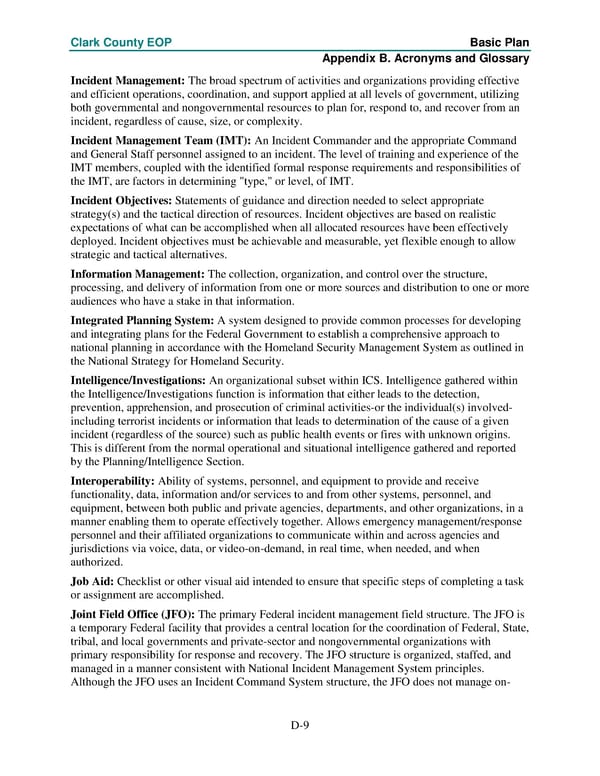Clark County EOP Basic Plan Appendix B. Acronyms and Glossary Incident Management: The broad spectrum of activities and organizations providing effective and efficient operations, coordination, and support applied at all levels of government, utilizing both governmental and nongovernmental resources to plan for, respond to, and recover from an incident, regardless of cause, size, or complexity. Incident Management Team (IMT): An Incident Commander and the appropriate Command and General Staff personnel assigned to an incident. The level of training and experience of the IMT members, coupled with the identified formal response requirements and responsibilities of the IMT, are factors in determining "type," or level, of IMT. Incident Objectives: Statements of guidance and direction needed to select appropriate strategy(s) and the tactical direction of resources. Incident objectives are based on realistic expectations of what can be accomplished when all allocated resources have been effectively deployed. Incident objectives must be achievable and measurable, yet flexible enough to allow strategic and tactical alternatives. Information Management: The collection, organization, and control over the structure, processing, and delivery of information from one or more sources and distribution to one or more audiences who have a stake in that information. Integrated Planning System: A system designed to provide common processes for developing and integrating plans for the Federal Government to establish a comprehensive approach to national planning in accordance with the Homeland Security Management System as outlined in the National Strategy for Homeland Security. Intelligence/Investigations: An organizational subset within ICS. Intelligence gathered within the Intelligence/Investigations function is information that either leads to the detection, prevention, apprehension, and prosecution of criminal activities-or the individual(s) involved- including terrorist incidents or information that leads to determination of the cause of a given incident (regardless of the source) such as public health events or fires with unknown origins. This is different from the normal operational and situational intelligence gathered and reported by the Planning/Intelligence Section. Interoperability: Ability of systems, personnel, and equipment to provide and receive functionality, data, information and/or services to and from other systems, personnel, and equipment, between both public and private agencies, departments, and other organizations, in a manner enabling them to operate effectively together. Allows emergency management/response personnel and their affiliated organizations to communicate within and across agencies and jurisdictions via voice, data, or video-on-demand, in real time, when needed, and when authorized. Job Aid: Checklist or other visual aid intended to ensure that specific steps of completing a task or assignment are accomplished. Joint Field Office (JFO): The primary Federal incident management field structure. The JFO is a temporary Federal facility that provides a central location for the coordination of Federal, State, tribal, and local governments and private-sector and nongovernmental organizations with primary responsibility for response and recovery. The JFO structure is organized, staffed, and managed in a manner consistent with National Incident Management System principles. Although the JFO uses an Incident Command System structure, the JFO does not manage on- D-9
 Emergency Operations Plan Page 112 Page 114
Emergency Operations Plan Page 112 Page 114